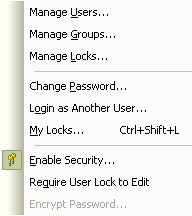There are two possible security policies in Enterprise Architect:
| 1. | In the first mode, all elements and diagrams are considered unlocked and, as necessary, you can lock any element or set of elements at the user or group level. This mode is good for cooperative work groups where there is a solid understanding of who is working on which part of the model, and locking is used mainly to prevent further changes or to limit who has access to a part of the model. |
| 2. | The second mode is more rigorous. It assumes everything is locked until explicitly checked out with a user lock. In this mode, an Enterprise Architect model is read-only until you apply an editing lock to one or more elements. A single 'check out' function is available on a diagram to check out the diagram and all contained elements in one go. There are also functions on the context (right-click) menus of packages, diagrams and elements in the model browser to apply a user lock when this form of mode is in use. You would use this mode when there is a strict requirement to ensure only one person can edit a resource at one time. This is suitable for much larger projects where there might be less communication between users. |
Toggle between these modes using the Project | Security | Require User Lock to Edit menu option:

Note: When you add new elements in Mode 1 (elements editable by default), no user lock is created automatically for the newly created element.
Note: When you add new elements in Mode 2 (elements locked by default), a user lock is created on the new element to enable instant editing.
See Also


